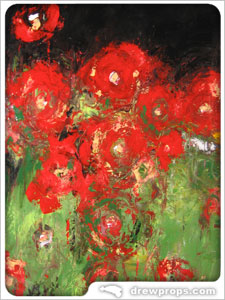
I know that art is subjective and that one man’s trash is another man’s treasure, but it’s hard to remember artistic aphorisms when you’re staring down the barrel of somebody’s trashy art collection. How many times have you found yourself turning your head sideways trying to make sense of what I like to call a “disaster in oil” perched on someone’s living room wall? How many times have you squeezed out an appreciative, knowing smile when that art-proud owner gestures toward a framed testament to bad taste to announce that it’s a “What-cha-ma-kinsky” as though the works of “Whatchamakinsky” were being taught in schools and sought after by money-laden 1980’s era Japanese businessmen? The reality is that very few of us will ever buy work by an artist who will break out and gain notoriety, the signal-to-noise ratio is simply too high. The best we can hope to do is to bore our friends and acquaintances with our perceived good taste.
Having said all that, I’d like to tell you about my latest purchase of a Whatchamakinsky, aka Atlanta artist Leann Zafuto, whose work is currently being shown at boswellGallery in Decatur. I think that Leann’s work stands a very good chance of breaking the Art Barrier and I’d recommend that you consider picking up one of her paintings while she’s still affordable.
The Art Barrier is the dividing line between consumer art and serious art and it can be just as damned subjective as art itself with one big difference: value. When an artist breaks the Art Barrier they begin being recognized by art critics, which generally leads towards interest by “serious” collectors who rely on the tastes of the aforementioned critics to help them invest their buckets of money.
But what if you don’t have buckets of money to invest?
It’s easier than any point in history for the average person to own a piece of artwork, heck, you can find it for sale practically anywhere in a large city. Coffee shops, restaurants, hair salons, clothing boutiques, department stores and even some of your finer gas stations offer a nice selection of artwork (though the ones at the gas station tend to be black velvet portraits of Elvis and/or large-breasted warrior women). Any of those places might supply you with a piece of artwork that you will cherish for the rest of your life but the chances are slim that you’re going to land on a piece of department store artwork that will one day find your grandchildren doing jigs of joy when an art appraiser on the Antiques Roadshow 2030 tells them how much the painting is worth.
So just buying cheap art isn’t necessarily the answer.
Of course you could go to an art gallery but that’s certainly no guarantee that you’re going to find artwork that’s going to break the Art Barrier. There’s always the possibility that the only thing that’s going to get broken is your wallet. I’ve been in plenty of art galleries that left me wondering who the fools are keeping them in business. But I know who those fools are. An art purchase is to most buyers as personal a statement as the creation of the art was for the artist. Buyers are emotionally invested in their purchases and will sing the praises of the artist to anyone unlucky enough to wander near their personal collection (tip: never ask about artwork in people’s homes). Consumer enthusiasm is good, but is that going to make an artist’s work more valuable down the road? Probably not. My Mom and one of her sisters love Thomas Kinkade but the stuff they buy is only worth the materials they’re made from.
So how do you find artists who might really become collectible in the future? Crap, I don’t know. Get one of those fancy flying Deloreans from the movies. Or follow my simple, unproven steps to artistic collecting success:
1. Stop shopping for art in department stores and art depots. Now.
2. Pick artists who concentrate on their art. Stay away from dabblers.
3. Look for artists who work in recurring themes.
4. Research. Tour your local galleries for a couple of months to learn the artistic “lay of the land” in your region.
5. Find out who the artists are talking about. Maybe you’ll even become friends with a few. That’s never bad… unless they cut off an ear and you have to drive them to the hospital.
6. Stay away from crazy artists. Actually, you might want to collect them. The wildest stories will last the longest so if you find an artist whose work seems to be appreciated by the arts community AND they’re a character, all signs point toward “buy”.
7. STOP listening to what I have to say and go buy your own dang art. Dang.
That’s all I’ve got for art collecting today. I’ve given you a very big tip on Leann Zafuto’s paintings, the rest is up to you.
Hi! I emailed you about a week or two ago at the email Elliott gave me…thank you so much for this. Please keep in touch with me… so appreciate this and your support of Art For Justice And Victims United! Call or email me! Leann